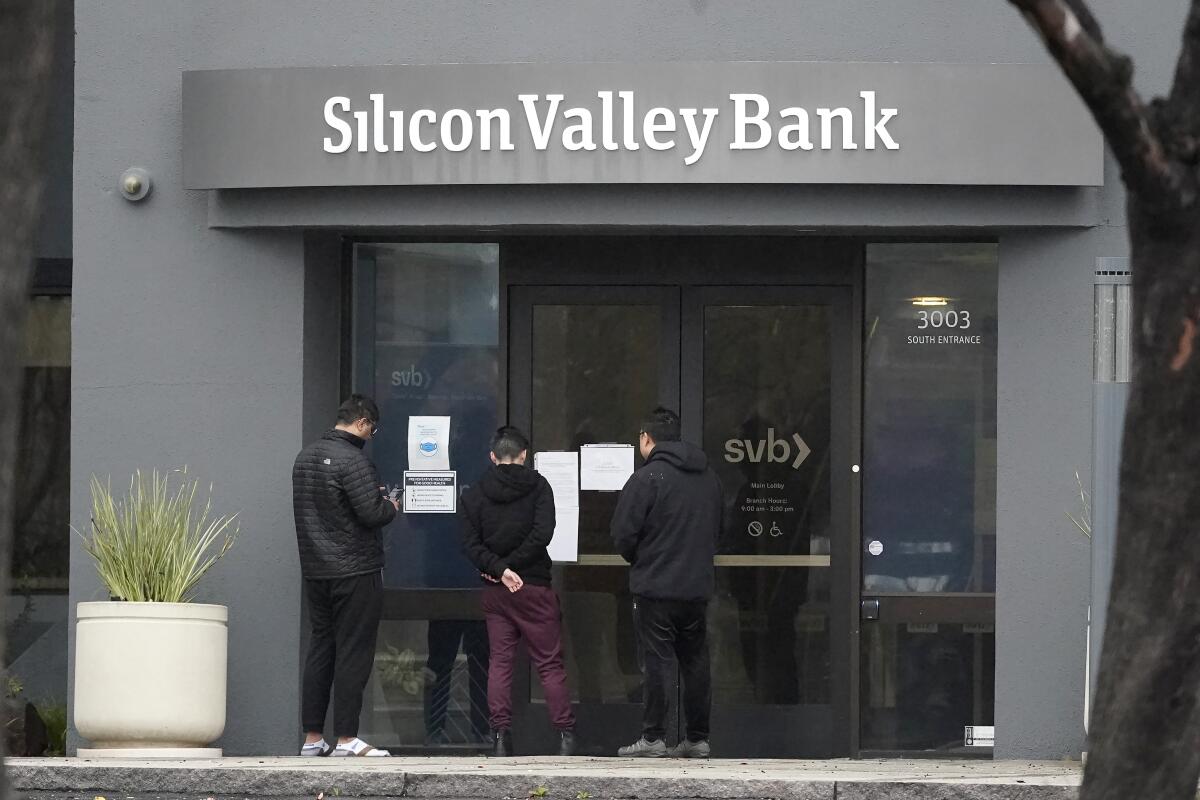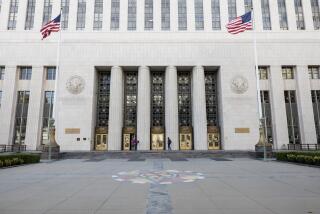Opinion: Beyond saving Silicon Valley Bank’s depositors, here’s what needs to happen next

- Share via
Before Thursday, Silicon Valley Bank was regarded as being in “sound financial condition.” But on that day it experienced attempted withdrawals of $42 billion, about a third of its U.S. deposits. By close of business, the run on the bank made it incapable of paying its obligations as they came due. On Friday, the California Commissioner of Financial Protection and Innovation took possession of the bank’s property and business.
The Federal Deposit Insurance Corp., which insures deposits up to a limit of $250,000 per individual account or for a corporation at a single bank, was immediately appointed as the receiver. In some ways, SVB was unusual. Around 97% of its deposits (by value) were uninsured. This is because the bank catered primarily to the tech community, with many of these companies and nonprofits (perhaps up to 37,000 of them) parking their operating cash there.
Its collapse raised critical questions: What protection should be provided to depositors at SVB with uninsured amounts? Will there be problems for similarly situated banks? And what official action would be appropriate to head-off any potential cascade of bank failures?
Some preliminary answers were provided Sunday night by Treasury Secretary Janet L. Yellen, Federal Reserve Chair Jerome H. Powell and FDIC Chairman Martin J. Gruenberg: All bank depositors with SVB and with Signature Bank, which was closed by New York authorities on Sunday, will be fully protected. The Federal Reserve will also make available additional funding to ensure banks have enough liquidity to meet the needs of all depositors trying to make withdrawals.
The hope is that this rapid response will stop any further panic that could drive more bank runs. It appeared to be working on Monday, when all depositors’ funds in SVB became available. The stocks of midsized regional banks, however, plummeted as equity investors worried about the sudden collapses of SVB and Signature Bank.
Going forward, the FDIC will also manage SVB’s remaining assets, which are of high quality, including government securities and mortgage-backed securities guaranteed by government sponsored enterprises. The recovery value of these assets will be high, and they can be sold immediately.
Preventing bank runs is the immediate fire to put out, but the underlying problem that weakened Silicon Valley Bank — and may also leave other banks susceptible — has yet to be addressed.
In this case, a significant factor was how SVB was affected by the Federal Reserve and its macroeconomic priority to bring down inflation. Somehow this message did not filter down to corporate leaders at the bank.
SVB was brought down because it and its Fed supervisors did not pay attention to what Powell said would happen — that the Fed would raise interest rates if inflation stayed stubbornly high, as it has. Instead, SVB’s assumption that interest rates would remain low appeared to drive its investment strategies.
For many years, SVB was well regarded, apparently successful and had the best possible connections to banking regulators. The chief executive, Greg Becker, has been on the board of the San Francisco Fed since 2019 (he was removed from that board on Friday). Mary Miller, former undersecretary for domestic finance at the U.S. Treasury Department, was on the board of SVB.
For a while, nothing seemed amiss. And when startups received a flood of funding during the pandemic and immediately after, deposits at SVB rose by about $100 billion, more than doubling its balance sheet. SVB leadership used these funds to buy long-term U.S. government-backed bonds that are free of credit risk (they never default).
Unfortunately, as the bank’s management and its Fed supervisors should have known, such assets are not free of interest rate risk — meaning that as the Fed raised interest rates over the last nine months, the market value of SVB’s portfolio declined. Eventually, the value of its assets fell so much that concern about solvency arose, and SVB was unable to find enough cash to match the attempted $42-billion withdrawal on Thursday.
The bank’s miscalculation of risks, based on over-optimism of future interest rates, was a central problem, creating a vulnerability that helped trigger the bank run. But Fed supervisors also apparently failed to see the interest rate risk inherent in SVB’s big bond buying spree or to do anything about it (e.g., to require the bank to hedge that risk).
As a result, the Federal Reserve and other officials feel pressed to provide additional support to the banking system. There has been widespread concern since Friday about a run on other midsized banks, leading to other insolvencies — hence the move to guarantee all deposits at SVB and Signature.
In 2008, the regulation and supervision of big Wall Street traders broke down, resulting in a major financial panic, millions of jobs lost and the Fed loosening monetary policy as much as possible to prevent even worse outcomes.
In 2023, it is the supervision of regular commercial banks that has broken down. The failure of a $200-billion bank should not bring down the financial system. But a breakdown in supervision is another matter.
Fearing a major financial panic, the Fed and other authorities seem willing to provide a de facto blanket guarantee for all bank deposits. (Total bank deposits in the U.S. are around $18 trillion, of which about $10 trillion are FDIC insured.)
To be fully effective, this extension of deposit insurance has to be permanent, and all such insurance should be paid for through appropriate contributions from banks.
Going forward, federal authorities and the taxpayer will ultimately be responsible for more of the downside risk associated with poor risk management at banks. Consequently, regulation and supervision will need to be strengthened in an appropriate manner. Many people said this after 2008, but not enough was done.
A well-regulated system is still the right goal. This time around, the Federal Reserve needs to overhaul and improve its bank supervision — and to make that consistent with its macroeconomic policy for interest rates.
Simon Johnson is co-chair of the CFA Institute Systemic Risk Council, former chief economist of the International Monetary Fund and a professor at MIT Sloan.
More to Read
A cure for the common opinion
Get thought-provoking perspectives with our weekly newsletter.
You may occasionally receive promotional content from the Los Angeles Times.










